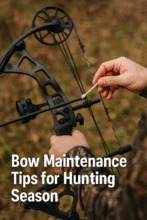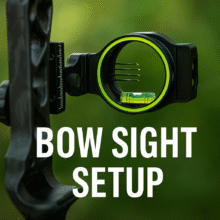Latest Bow Technology Innovations 2025

The world of archery is undergoing an exciting evolution. What once were purely mechanical tools now feature cutting-edge materials, ultra-refined cam systems, and precision engineering that rival high-performance firearms. For 2025, manufacturers have pushed innovation in several key areas: material science, cam & pulley design, tuning ease & modularity, and ergonomics / stability for the shooter.
In this post, we’ll dive deeply into the major trends and technologies shaping the latest compound bows and hunting/target platforms for 2025 so archers, gear-heads, and retailers alike can stay ahead of the curve.
Table of Contents
- 1. Advanced Riser & Limb Materials
- 2. Cam Systems, Modules & Tuning Innovations
- 3. Stability, Vibration & Noise Reduction
- 4. Faster, More Efficient Platforms
- 5. Modular / Customizable Features & Accessory Integration
- 6. Target & Hunting Use-Case Enhancements
- 7. What Retailers, Bloggers & Enthusiasts Should Focus On
- 8. Example: Bow Models & Tech to Watch in 2025
- 9. Future Trends & What’s Coming Next
- 10. Summary & Take-Home Points
1. Advanced Riser & Limb Materials
One of the most visible innovations in 2025 is the shift to hybrid‐ and ultra‐lightweight materials for risers (the central frame of the bow) and limbs. These developments improve stiffness, reduce weight, dampen vibration, and enhance stability.
1.1 Hybrid aluminum + carbon risers
For instance, in a recent review of 2025 flagship compound bows, one model was praised for debuting “the industry’s first hybrid riser combines aluminum and carbon to create a long, stiff, and lightweight riser.”
What this means in practice:
- Carbon sections provide lightness and damping (vibration absorption)
- Aluminum or alloy “skeleton” sections provide stiffness and structural integrity
- Together they allow longer axle-to-axle lengths without the “floppy” feel of older long bows
1.2 Ultra-lightweight limbs and riser weight reduction
Another trend: reducing overall bow weight while maintaining stability. For example, the 2025 class of compound bows was described as “the best I’ve ever tested built on new technologies and provided increased stiffness and reduced weight.”
Manufacturers like Bowtech (which has a 2025 lineup highlighting an “AeroMag Magnesium Riser”) are emphasizing advanced metal alloys in the riser for improved performance.
1.3 What this means for you/your customers
- Lower weight = easier to carry, less fatigue during long hunts or target sessions
- Higher stiffness = better energy transfer to the arrow (less flex loss)
- Better damping = less hand shock, better follow-through, improved accuracy
- Longer axle-to-axle (ATA) length without sacrificing speed or maneuverability
2. Cam Systems, Modules & Tuning Innovations
Another major area of advancement in 2025 is the cam and pulley system of compound bows. These determine how smooth the draw cycle is, how efficient the bow is, how quiet it shoots, and how tunable it is.
2.1 More precision modules and cam adjustments
In the 2025 review, bows featured modular cams, micro-adjustments for draw length and let-off, and sophisticated tuning systems. For example:
- One bow used a cam system that allowed draw‐length adjustment in ¼-inch increments and let-off options of 75 %, 80 % and 85 %.
- Another boasted a “dead-lock cam system” and an easy “Tune” hex slot to adjust cam lean.
2.2 Return to “longer ATA” designs with smoother draw cycles
Interestingly, some manufacturers returned to longer axle-to-axle lengths in 2025, while delivering improved draw cycles. For example, the model from Bowtech with 34″ ATA (the “Proven 34”) was praised as having “remarkably smooth” draw cycle despite being longer.
2.3 Integrated mounting & accessory-friendly systems
The 2025 lineup from Bear Archery introduced what they call “The Integrate Mounting System®” and Picatinny sight mounts built into their bows, reflecting how accessory integration is becoming standard.
2.4 Why this matters
- A smoother, more consistent draw cycle means better accuracy and less shooter fatigue.
- Modular cams and micro-adjustments mean bows can adapt better to different arrow weights, draw lengths, and tuning preferences.
- Accessory-friendly mounting allows archers to outfit sights, rests, stabilizers more easily and keep the platform optimized.
- Tunability and less need for specialized tools/training means easier maintenance and better long-term performance.
3. Stability, Vibration & Noise Reduction
Precision archery isn’t just about speed and weight—it’s about how stable the platform is, how little the bow vibrates, and how quiet it is (especially for hunting). In 2025, the industry has made noticeable strides here.
3.1 Better damping materials and riser designs
As noted, hybrid risers (aluminum + carbon) and advanced limb‐materials allow better damping of shock. One reviewer highlighted that the hybrid‐riser design “minimize[d] pin float and help[ed] build shooting confidence.”
3.2 Noise and vibration tests show improvements
In a comparative test of 2025 bows:
- One bow (Hoyt RX-9 Ultra) was cited as “exceptionally accurate … dead in the hand … the quietest bow in the test.”
- Another (Prime Form) achieved extremely tight groups but was noted to produce higher post-shot noise / hand shock — showing the margin for improvement still exists.
3.3 Shooter ergonomics and grip stability
Stability also ties into how the archer interacts with the bow: grip shape, balance, and how the bow sits at full draw. For example, the “center grip” technology mentioned in one review improved stability by shifting mass below the grip.
3.4 Real-world benefits
- Less vibration = less hand fatigue, more consistent aiming, less shooter-induced error
- Less noise = better stealth in hunting situations
- Better ergonomics = less torque, more comfortable draw, more consistent shot execution
- More predictable performance = easier tuning and better results, especially when tuning for different arrow/broadhead setups
4. Faster, More Efficient Platforms
While accuracy and stability are paramount, speed remains a key selling point. In 2025, manufacturers continue to push towards faster arrow velocities, but without sacrificing other performance metrics.
4.1 Performance metrics from 2025 testing
From the Field & Stream 2025 review:
- Some “best overall” bows achieved ~300+ fps speeds with 70-lb draw weight setups.
- The review stated: “This year’s bow class is the best I’ve ever tested … from short- to long-axle-to-axle … speed bows to smooth shooters.”
4.2 Trade-offs and optimization
Speed often comes with trade-offs (e.g., stiffer draw cycle, more hand shock). The good news: 2025 designs are finding better compromises. For example, the Bowtech Proven 34 prioritized accuracy and smoother draw over pure speed, and still performed very well.
4.3 Implications for the archer
- Faster arrow speed = flatter trajectory, better penetration (hunting) and less hold-time error (target)
- But speed must be balanced with accuracy and shooter comfort — a slower shot that’s precise is often better than a fast shot that’s inconsistent
- For retailers/bloggers: Highlight how 2025 models incorporate both speed and improved shooter interface, to appeal both to performance-seekers and comfort/accuracy-seekers
5. Modular / Customizable Features & Accessory Integration
Another major theme: bows now look more like modular platforms. From mounting systems, tuning features, to adjustable cams, the 2025 generation is all about custom-fit performance.
5.1 Integrated mounting systems
Example from Bear Archery: The 2025 Legend series features The Integrate Mounting System® plus Picatinny sight mounts built-in.
This means: less clutter, fewer aftermarket add-ons, better alignment and less guess-work for archers setting up sights, rests, stabilizers.
5.2 Quick-tune cam modules
As mentioned earlier: cams with hex-slots, quick-adjust set screws, micro-modules so the bow can adapt to different arrow lengths/spines/weights. The review example: “DeadLock Cam system … Tune hex slot … easy grip-angle adjustment via GripLock.”
5.3 What this means for consumers & sellers
- Easier tuning = lower barrier for new archers and fewer visits to pro-shops
- Accessory readiness = you can bundle bows with high-end sights/stabilizers, market the “ready-to-build” platform
- Custom feel without custom price = more archers will expect tailored fit and performance, and manufacturers are delivering
6. Target & Hunting Use-Case Enhancements
While many of the innovations benefit both hunting and target archery, several features in 2025 are tailored for specific use-cases: spot-and-stalk hunting, 3-D target, competitive field archery.
6.1 Shorter ATA for maneuverability
For hunting in dense terrain, shorter axle‐to‐axle (ATA) lengths help. For example, some 2025 models come in ~29.5″ ATA (e.g., the Mathews Lift X 29.5) yet still achieve excellent speed and accuracy.
6.2 Long ATA for stability / target platforms
Conversely, longer ATA bows (like ~33-34″) are back in fashion for smooth draw cycles and high-end target or hunting platforms, as mentioned above with the Proven 34.
6.3 Quiet, minimal vibration for hunting
As noted above: the quietest bow tested in 2025 was highlighted as “exceptionally … dead in the hand,” important in hunting where stealth counts.
6.4 Tuned for broadheads & hunting setups
Reviews stressed that these 2025 bows aren’t just for field-points—they are tuned for broadheads, mechanicals, 3-D applications, variable arrow weights, etc. This versatility increases value for serious hunters. Field & Stream
7. What Retailers, Bloggers & Enthusiasts Should Focus On
Given these innovations, what should your blog (on TheShootingGears.com) highlight? What should gear-buyers look for? What messaging sells? Here are key takeaways:
7.1 Highlight “Technology Value” not just brand
Instead of simply listing brand names, focus on what tech each bow offers: hybrid riser, modular cam system, integrated mounting, vibration damping, etc. Talk about “Why it matters”.
7.2 Segment by user need
- For hunters: Low weight, short ATA, quiet/steady performance, broadhead-ready tuning.
- For target/3-D shooters: Accurate, smooth draw cycle, customizable cams, integrated mounting for stabilizers/sights.
- For entry-level/intermediate: Emphasize tuning ease, modularity, lower maintenance.
7.3 Use data / reviews
Incorporate third-party testing (like the Field & Stream 2025 review) to back claims: e.g., “Top speed ~300 fps”, “smoothest draw cycle”, etc. Field & Stream
7.4 Educate on tuning & ergonomics
Explain why grip angle matters, why axle-to-axle length influences feel and performance, what let-off percentages mean, how to pick arrow spine w.r.t. new cam systems. This makes your blog valuable and shareable.
7.5 Feature visuals & comparisons
Use high-quality images of new bows, diagrams of cam systems, table comparisons between “2024 vs 2025 tech”, so that readers can see the evolution.
8. Example: Bow Models & Tech to Watch in 2025
Here are a few models and technology notes worth spotlighting (you can link or recommend these in your blog resource section).
- Bowtech “Virtue” series: features AeroMag magnesium riser and advanced tuning just for 2025.
- Bear Archery “Legend” series (Persist 33, Whitetail INT, Legend 30): includes Integrate Mounting System®, Picatinny mounts, improved cam systems.
- The Field & Stream top picks: e.g., PSE Mach 33 DS (Best Overall) and Hoyt RX-9 Ultra (Quietest) show how 2025 tech meets varied archery needs.
When you write your blog, you could include mini-profiles of each (with specs, standout tech, who it’s for) to give readers actionable insights.
9. Future Trends & What’s Coming Next
Looking ahead beyond 2025, some emerging directions to keep an eye on:
- Further material innovations: full-carbon risers, nano-composites, even lighter limbs
- More integration of electronics or sensor feedback (e.g., shot-analysis sensors on bow)
- More “smart” cam systems with digital tuning or adaptive modules
- Bow designs that integrate better with accessory ecosystems (e.g., stabilizer interface, arrow telemetry)
- Personalized manufacturing: riser geometry optimized for individual shooter biomechanical data
Mentioning this in your blog helps position TheShootingGears.com as forward-looking and authoritative.
10. Summary & Take-Home Points
In conclusion, 2025 marks a groundbreaking year for bow technology, blending innovation, precision, and performance like never before. From hybrid riser designs and lightweight carbon materials to advanced cam systems and integrated accessory mounts, the latest compound bows redefine what archers can expect in terms of speed, accuracy, and customization. These innovations don’t just make bows faster they make them smarter, quieter, and more adaptable to every shooter’s needs, whether in the hunting field or on the competition range. The focus has clearly shifted toward creating a seamless connection between the archer and their equipment, allowing for greater control, reduced vibration, and easier tuning without sacrificing power. As we move further into 2025, archers who embrace these technological advancements will experience a noticeable leap in performance, confidence, and consistency with every shot. The future of archery is here and it’s lighter, smoother, and more intelligent than ever.






